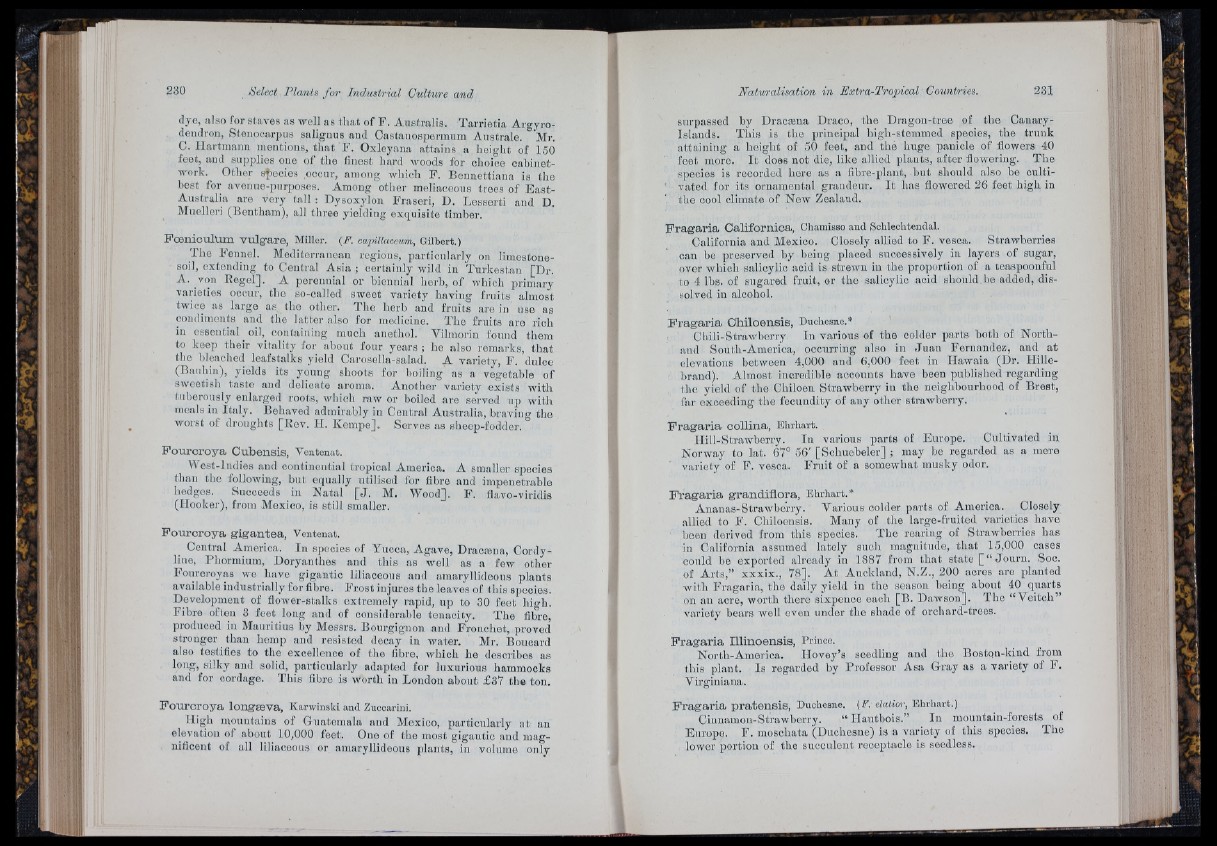
ilyo, also for slaves as well as lliat of F. Auslralis. ïa r rio tia Ai'gyro-
(lomlron, Stoiioeiirpus salignus and Caslanospennnm Australe. Mr.
C. Hartmann mentions, th a t F. Oxleyana attains a height of l.'iO
feet, and snjiplies one of tlio tiiiost liard woods for oiioico cabinetwork.
Otbor sfiocies ooonr, among wliicli F. Reimottiana is the
liost for avoime-]mrjioses. Among otlior moliaceons trees of East-
Australia are vory tall : Dysoxyloii Frasori, H. Lossorti and D.
Muelleri (Bentliain), all tlireo yieiding exijuisito timber.
Poeniculüm vulgare, Miller. (P. caqnllaceum, Gilbert.)
Tlio Feimel. Mediterranean regions, partieiilarly on limostoiio-
soil, extending to Central Asia ; certainly wild in Turkostau [Dr.
A. von Regel]. A poreniiial or liionnial liorb, of wliicli primary
variolios occur, tlio so-calied sweet variety having fruits almost
twice as largo as tbo otlier. TIio lierli aud fruits are in use as
oonilimouts and tlio latter also for modiciuo. Tlio fruits aro rich
ill essential oil, ooiilaiiiing mucli anetbol. Vilmorin found tiiein
to keep their vitality for abont four yoars ; lie also remarks, tliat
tlio liloaoliod leafstalks yield Ca-rosella-salad. A variety, F. dulco
(Ranliin), yields its young slioot.s for lioiliiig as a vogotalile of
sweetish taste and dolioato aroma. Anotlior variety exists witli
tnborously enlarged roots, wliioli raw or boiled are served np witli
meals in Italy. Rebaved admirably iu Central Australia, iiraving tbe
worst of droughts [Rev. H. Kompo]. Serves as sbeop-fodder.
Pourcroya Oubensis, Ventenat.
West-Iudies and coiitiiioiitial tropical America. A smaller species
tliaii tbo following, but equally utilised for fibre and impenetrable
bodges. Suocoods in Natal [ J . M. Wood]. F. fbivo-viridis
(Hooker), from Mexico, is still smaller.
Pourcroya gigantea, Ventenat.
Central America, in species of Yucca, Agave, Dracæna, Cordyline,
riiormiuin, Doryantlios and this as well as a few other
Fonrcroyas wo have gigantic liliaceous and amarylliileous plants
available industrially for fibre. Frost in jures tlio leaves of tbis sjiooies.
Dovclopmout of llower-stalks extremely rapid, up to 30 feet high.
Filiro ofloii 3 foot long aud of considerable tenacity. Tlio fibre,
produced in Mauritius by Messrs. Bourgiguon and Froucliet, proved
stronger tban liomp and resisted decay iu water. Mr. Boucard
also tostilies to tbo excellence of tho fibre, which he doseribos as
long, silky and solid, particularly adapted for luxurious iiammocks
and for cordage. Tliis fibro is wort-li in Loudon about .£37 tbe ton.
Pourcroya longæva, Karwinski and Zuccarini.
iligb mouiitaiiis of Guatemala and Mexico, particularly at an
elevation of abont 10,000 foot. Oiio of tbo most gigantic a-iid iiiag-
nificoiit of all liliaceous or amiiryllidoous plants, in volume only
| î
surpassed by Dracosua Draco, tbe Di'iigou-tree of tlio Canary-
Islands. This is tho principal liigli-stomracd spocios, the trunk
attaining a hoiglit of 50 feet, and the huge panicle of flowers 40
foot more. I t does not die, liko allied plants, after flowering. Tbe
species is recorded liere as a fibrc-plant, but sliould also bo culti-
' vatod for its ornamontal grandeur. I t bus flowered 26 feet liigh in
tbe cool climate of Now Zealand.
Fragaria Californica, Chamisso and SoWechtendal.
California and Mexico. Closely allied to F. vesca. Strawberries
can bo preserved by being placed sneoessivoly in layers of sugar,
over wliicb salieylio acid is strewn iu liio proportion of a toaspoonful
to 4 lbs. of sugared fruit, or tho salicylic acid sliould be added, dissolved
in alcohol.
Fragaria Chiloensis, Duchesne.*
Cbili-Stvawborry in various of the colder parts both of Nortk-
luid Soutb-Amoriea, ooourring also iu Ju a u Fernandez, and at
elevations between 4,000 and 6,000 foot iu Hawaia (Dr. Hille-
liraiid). Almost incredible aocounts liave been published regarding
tlio yield of tbe Cbilooii Strawberry in tlio neiglibonrliood of Brest,
iiir exceeding the focmidity of any other strawberry.
Fragaria collina, Khrhart.
Hill-Strawberry, in various parts of Enropo. Ciiltivatod in
Norway to iat. 67° 56' [Solmobelor] ; may bo regarded as a moro
variety of F. vosoa. F ru it of a somewhat musky odor.
Fragaria grandiflora, Khrhart.*
Aiiauas-Strawbony. Various colder parts of America. Closely
allied to F. Cbilocn'sis. Many of tbo largo-fruited varieties have
boon derived from tliis spocios. 'The roaring of Striiwlierrios has
in California assvimod latoiy snoii magnitude, th a t 15,000 cases
could bo exported already in 1887 from th a t stale [ “ Journ. Soc.
of Arts,” xxxix., 78]. A t Auckland, N.Z., 200 acres aro ]ilantod
with Fragaria, tlio daily yield in the season being about 40 quarts
on an acre, worth thoro sixponco oacli [15. Dawson]. 'The “ Voitoli”
variety bears well even under tlio sliado of orcliard-troes.
Fragaria Illinoensis, Priuce.
Nortli-Aiuerica. Hovoy’s soodling and tlie Bostqn-kiiid froin
Ibis plant. Is regarded by Trofessor Asa Gray as a variety of F.
Virgiiiiana.
Fragaria pratensis, Duchesne. (F. elatior, Khrliart.)
Ciunimioii-StrawbeiTy. “ Hautbois.” In mouiitain-forosts^ of
Enropo. E. uioscliata (Dnoliosno) is a variety of tbis species. 'Tbo
lower portion of tlie sueculont rocoptaclo is seedless.